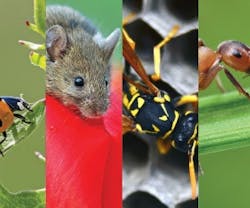April showers bring May flowers, but what if those budding blossoms also attract an army of ants?
Without oversight, your landscaping can provide an ideal habitat for insects and rodents. If you don’t want pests inside your building, make sure they aren’t making a home right outside your door.
Beat around the Bush
As long as pests have food, water, optimal temperatures, and a place to breed, they will survive and thrive, explains Ron Harrison, an entomologist and director of technical services for Orkin. Your landscaping may be just the ticket.
Thick vegetation, mulch, and bushes are attractive to animals of all types. “Heavy groundcover harbors ants, spiders, millipedes, pill bugs, crickets, cockroaches, rats, mice, and snakes,” says Stoy Hedges, an entomologist with Terminix.
Flowering plants that are colorful and fragrant will draw bees and other pollinators, just as fruit attracts yellow jackets and rodents, Harrison adds. Mother Nature is opportunistic, and where there’s one kind of pest, others will likely follow as an ecological domino effect.
“The more pests that live close to your building, the more likely they are to enter,” cautions Hedges.
Buzzing with Ideas
The spring thaw is the perfect time to focus on integrated pest management (IPM). IPM calls for preventive measures, such as monitoring and natural repellents, rather than broad chemical treatments.
“It is much easier to prevent or address pest activity early on rather than deal with a full-blown infestation,” Harrison stresses.
You can beautify your property without sacrificing pest management principles. Try these six tips to make your landscaping a layer of defense against uninvited critters.
1) Know the Signs
Pest activity can easily be confirmed with visual inspections. Have your groundskeepers report sightings and look for signs of colonies.
Ant trails or mounds, wasp nests, and rodent burrows can be spotted with the naked eye, says Hedges. Damage to vegetation may also provide a clue to what type of pests are present. You can also set out no-kill traps, Harrison adds.
2) Choose Trees Wisely
“Branches that touch a building are highways for ants and rodents to gain access to the roof and walls,” Hedges explains. “When planting trees and shrubs near buildings, consider the mature branch spread of the plant. Don’t plant a tree that will grow to a 30-foot span at maturity within 10 to 15 feet of the building, otherwise branches will need to be continually pruned to keep them off the structure.”
3) Pay Attention to the Weather
Do you apply pest treatments like clockwork each year? If so, you may be off target depending on when the seasons change. It’s best to use a “wait and see” approach, recommends Harrison.
When applied at the right time, treatments are more effective, diminish chemical exposure, reduce costs, and conserve labor and materials.
4) Minimize Mulch
Mulch is great way to recycle clippings, but remember to remove last year’s remnants before adding fresh material.
“We see companies dumping mulch year after year until there’s a layer a foot deep. All it’s doing is serving as a haven for pests,” says Harrison.
You can also use rocks as permanent ground cover, which is a less inviting habitat.
5) Sweep up Standing Water
Mosquitos may not be as fearsome as cockroaches, but they can be just as much of a nuisance. These pests are attracted to shallow water.
“If you have a few inches of standing water, mosquitos can go through their whole breeding cycle in less than five days in the summer,” Harrison explains.
If you have water features, test them for mosquito larvae. You can also reduce ponding water by using drip irrigation instead of sprinklers, notes Harrison, which has the added benefit of lowering your water bills.
6) Keep Records
You already keep maintenance records for your building equipment – do the same for your pest management program. Take note of when pest activity starts and what measures were used.
“If you have historical records for pest activity, then you can schedule proactive work to head off recurring problems,” says Harrison. “Remember, a pest is only an animal that’s out of place.”
Jennie Morton [email protected] is senior editor of BUILDINGS.
About the Author
Jennie Morton
A former BUILDINGS editor, Jennie Morton is a freelance writer specializing in commercial architecture, IoT and proptech.
